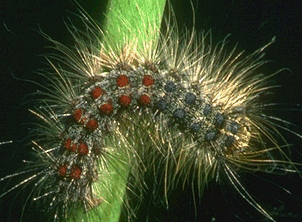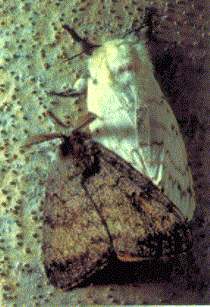 Gypsy moth larvae
Gypsy moth larvae

Gypsy moth adults
For More Information on the Gypsy
Moth:
USDA Forest
Service Information
Ohio State University Extension
|
Status in Nebraska:
The gypsy moth is not currently found in Nebraska.
Distribution:
This insect is found in the northeastern United States and is gradually
working its way south and west.
Origin and Time of Introduction:
The gypsy moth was introduced to Boston, Massachusetts in 1868 or 1869.
It came from Europe and Asia.
Common Characteristics:
Larvae are caterpillars which can reach up to 3 inches in length.
They are brown or black and have blue and red spots on their backs.
They feed in their host trees at night.
Environmental Impact:
It feeds on over 500 species of plants, but seems to prefer oak trees (Quercus
spp.).
Management:
Use a sticky substance as a trap on host plants, use Bt (Bacillus thurgiensis
var. kurstaki) to kill them. There are many ways of practicing biological
control on them, or a broad spectrum insecticide can be used.
The gypsy moth is a serious pest of forests, shade and fruit trees,
and ornamentals in the northeastern United States. It was brought to the
U.S. from Europe in the 1860s to cross it with the silkworm to improve
silk production. Some of the insects escaped captivity and became established
in the surrounding forest.
In the early 1980s an infestation of gypsy moths occurred in Lincoln,
Nebraska. The insects were found shortly after their introduction, and
control efforts are believed to have eradicated the insects from the area.
In 1991, gypsy moths were brought into the Omaha area on infested nursery
stock. Most of the infested trees have been located and treated or destroyed.
Currently, an effort is underway to locate and eliminate any pockets of
infestation that may have resulted from this introduction. |